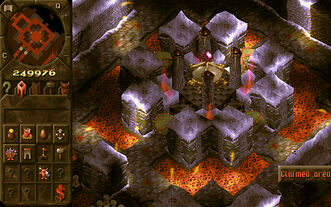
A Dungeon Heart in Dungeon Keeper 1
In the action-strategy game Dungeon Keeper and its sequels, players are required to build vast underground complexes known as dungeons and gather hordes of evil creatures with which to battle against the heroes that defend the Overworld. As the Keeper of a dungeon, the player has to oversee the expansion of their territory by assigning tasks to their imp labour force such as digging new tunnels, claiming land and portals, fortifying the dungeon walls and gathering gold and gems to fund the dungeon's construction. With the appropriate spaces dug out, the Keeper can build rooms and facilities to attract, house, train and entertain the creatures that enter their dungeon. Depending on the rooms available and the skills of your creatures, they will find jobs to perform within the dungeon that will empower the Keeper and advance the game.
Rooms and Key Features[]
The list below details the various rooms and key elements of a dungeon. Some of these are absolutely vital to maintain a dungeon while others only become available in later stages of the game.
Dungeon Heart[]
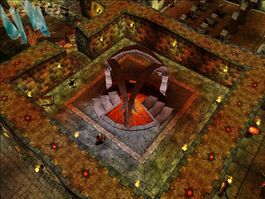
A Dungeon Heart in Dungeon Keeper 2
The Dungeon Heart is the living core of the dungeon and represents the life of its Keeper. This is a pre-built room from which every dungeon begins and must be protected at all costs. Heroes and even rival Keepers will seek to destroy the Dungeon Heart, and if they do, the player is defeated with all their territory reverting to an unclaimed state and any remaining creatures fleeing the dungeon.
In the first Dungeon Keeper, the Dungeon Heart appears to be a large, glowing white orb surrounded by arching golden plinths holding up a wine-red gem over the orb. In the sequel, the Heart resembles an actual organic heart that beats and pulsates within a stone well.
Portal[]
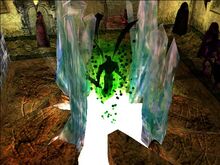
Dungeon Keeper 2: A Dark Angel rises from a portal
The Portal is the means by which most types of creature can enter the dungeon. These Portals cannot be built by the Keeper, but rather they must be found and then claimed by the Keeper's imps. They are usually located not far from the Dungeon Heart and can be claimed without difficulty, but the creatures which come through it will depend on what rooms are readily available in the dungeon. In Dungeon Keeper 2, a total of 15 creatures will emerge from a Portal and the Keeper must claim another (if there are any more in a realm) to gain any further creatures.
In Dungeon Keeper 1, the Portal appears to be an ornate stone gazebo with mist pouring from the pit beneath it. In DK2, the portal is a glowing fissure surrounded by four crystal spires. Other types of Portal also exist in DK2: the Hero Gate serves to transport heroes to the Underworld to oppose you, and the Mercenary Portal is capable of summoning renegade heroes to join the Keeper's forces.
Treasury[]
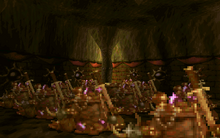
DK1: A fully stocked Treasure Room seen through a creature's eyes
The Treasury is the first room that the Keeper will be able to build. Here, the Keeper will store all of the gold and gems obtained by their imps. The more tiles a Treasury has, the more gold can be stored there. The Treasury is essential for a Keeper to build and maintain wealth with which to expand the dungeon by building new rooms and paying the creatures that reside within. In gameplay, Payday occurs every 8 minutes and gold will be deducted from the Treasury to pay the Keeper's minions. The amount of gold paid to each creature is dependent on the creature's species and their individual level; The higher level creatures will be paid more. If a Keeper discovers and mines large amounts of gold, the Treasury may need to be expanded to accommodate it all. Adversely, if the Keeper doesn't have enough gold to pay their creatures, they may find their minions growing angry and leaving the dungeon.
Lair[]
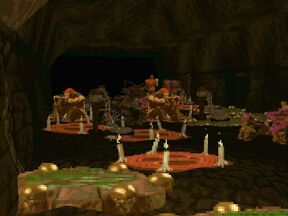
DK1: A densely populated Lair
The Lair serves as living quarters for any creatures that enter your dungeon. It initially appears as simple flat ground and no other features appear within it if more tiles are added. When creatures enter the dungeon for the first time, they will magically conjure their own unique bedding and will come to this place to rest after a hard day's work. This is also where creatures will heal after being injured in battle.
In later stages, the Keeper will likely have to build multiple Lairs to house their growing menagerie. Some creatures do not get along, eg. Spiders and Flies, and will fight among themselves if forced to share lair-space with each other.
Hatchery[]
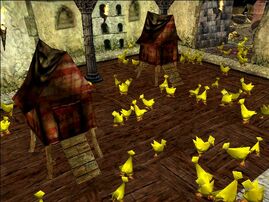
DK2: Hatchery
The Hatchery serves as the dungeon's source of food. Here, chickens will be generated to provide creatures with sustenance. Chickens are stupid and feeble, but also delicious, especially when eaten raw as creatures do. Creatures eventually get hungry over the course of their duties and will venture to the Hatchery to down a chicken or two. Some creatures eat more than their fair share, most notably the gluttonous Bile Demons, so a large Hatchery will be needed in later stages to sate the hunger of the entire creature pool.
In the first Dungeon Keeper, the Hatchery floor appears to be a simple dirt pit from which chicken eggs erupt and hatch periodically. In the sequel, the Hatchery room has wooden floorboards and contains chicken coops from which chickens are spawned.
Training Room[]
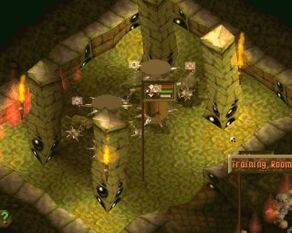
DK1: Training Room
The Keeper will require strong minions to protect the dungeon and slaughter heroes, and so the Training Room will be of great importance. Here, creatures that otherwise have no jobs to do will come and hone their fighting skills by exercising with the room's combat training apparatus. As creatures train, they steadily become stronger, rising to higher levels and gaining new stats and abilities. The highest level any creature can reach is Level 10. Depending on the species, a Level 10 creature will possess a wide variety of powers to use in battle.
In the first Dungeon Keeper, the Training Room is a murky grey-green room with iron weights attached to the walls and torches on the support pillars. The training apparatus that appears in the centre of the room is a rotating pillar covered in spikes and flails. In Dungeon Keeper 2, the Training Room is decorated with shields and weapons on the walls and creatures will train using dummies adorned with hero armour.
Barracks[]
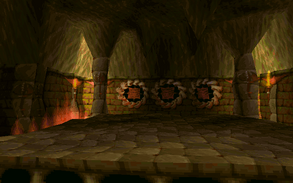
The Barracks is a room that only appears in Dungeon Keeper 1. Here, the Keeper may rally a specific group of creatures. When the Keeper drops a group of creatures into the Barracks, they will stay there until the Keeper possesses one of them. While in possession, the Keeper may lead the group to anywhere on the map. Not all creatures can group together, however, as some are natural enemies (such as Spiders and Flies) who refuse to work together. Horned Reapers also will not work with anyone as they are too wild and violent; even attempting to group a Reaper together with anyone could result in it going berserk.
In practice, the Barracks are not particularly useful, though more skilled players can make it work. The most useful aspect of the Barracks is that it can attract Orcs to the dungeon.
Library[]
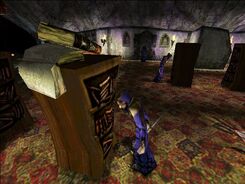
DK2: Warlocks at work in the Library. Be quiet or be fireballed.
The Library is where creatures can research new magic spells for the Keeper to use. A variety of creatures can make use of the Library, but the most efficient bookkeepers are Warlocks who are attracted to the dungeon by the Library and excel at research. In later stages, a larger Library will be required in order to stock a growing number of spells. Additionally, if heroes attack and start destroying the Library, any spells that are contained within could be lost and will have to be researched again once the Library is restored.
Workshop[]
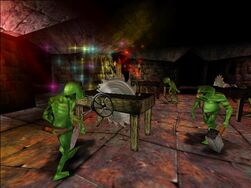
DK2: Trolls busy themselves in the Workshop
The Workshop is a useful room to have in order to build new defences for the dungeon. Here, the Keeper can put creatures to work manufacturing doors and traps to make the dungeon more secure. When the Workshop first becomes available, the Keeper will only be able to create basic wooden doors and alarms to alert the creature horde if the dungeon is breached, but over the course of the game more powerful devices will become available, though these are also much more expensive.
Trolls and Bile Demons are the ideal creatures to put to work in the Workshop as they enjoy getting their hands dirty. More academic creatures such as Warlocks will absolutely refuse to work here. Depending on its size and how many creatures are in the Workshop, devices can be produced at quite a rapid pace and it is recommended that all new doors and traps are installed immediately after production to avoid taking up space in the Workshop.
Bridges[]
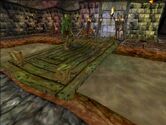
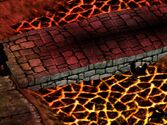
In both Dungeon Keeper games, bridges will become essential to the expansion of the Keeper's domain. Areas filled with water or lava can be found in various realms, preventing easy access to other areas for the Keeper's minions. While water can be tread by any non-flying creature, it will slow the movements of all creatures moving through it, except for Tentacles. Lava cannot be traversed at all by most creatures, except for Dragons and Hellhounds in Dungeon Keeper 1 and Salamanders in Dungeon Keeper 2.
In Dungeon Keeper 1, there is only one type of bridge, and while it appears wooden it can be built over water or even lava. There are two bridge types in Dungeon Keeper 2: Wooden and Stone. Wooden bridges are cheaper to build, but have a finite life if built over lava as they will catch fire and crumble after a time. Stone bridges, on the other hand, are resistant to lava and cannot be destroyed once built, except by the Keeper if they decide to sell their bridge tiles.
Guard Posts[]
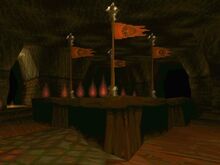
In Dungeon Keeper 1, the Keeper may build guard posts in key locations where creatures will dutifully keep watch for any intruders. Usually,a guard post will only need to be a single tile in size, though many of these should be built in different parts of the dungeon. When a creature is placed on a guard post, it will stay there until it needs to eat or sleep. Even problematic creatures such as Hellhounds, Vampires and the rage-prone Horned Reapers will behave when on guard duty. It is advisable that guard posts be built close to a Hatchery so that hungry guards won't have to be away from their posts for long. Also, it would be wise not build a guard post in a corridor that contains a boulder trap as a boulder will destroy the guard post when it rolls over it.
In Dungeon Keeper 2, Guard Posts have been replaced with the Guard Room. These rooms need to be larger than the old posts in order to be effective, though they possess a detection radius around them that will alert whatever creatures are in the room to the presence of enemies. They are best located on the edge of a Keeper's territory for early warnings.
Prison[]
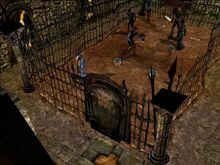
DK2: Two Wizards, three Rangers and a Lord of the Land are left to rot in Prison
In both Dungeon Keeper 1 and 2, the Keeper can build a Prison in order to capture heroes. With a Prison built, the Keeper can have their creatures render enemies unconscious in battle instead of kill them and the unconscious enemies will be dragged to the Prison by imps. While the Prison is occupied, it is up to the Keeper to keep the prisoners fed and alive. A Prison used in conjunction with a Torture Chamber presents the opportunity to convert heroes to evil and join the Keeper's forces, or to gain information about areas of the map that have yet to be uncovered. Alternatively, the Keeper can let prisoners starve to death and reanimate as Skeletons, gaining a nice supply of easy-to-manage minions that do not require food, rest or payment. However, the number of prisoners a Prison can hold depends on its size; if a Prison becomes overcrowded, a prisoner will escape as the last enemy is deposited inside.
Torture Chamber[]
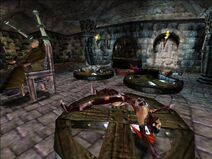
DK2: Several heroes are tortured for information while a Dark Mistress has just gone to have some fun.
In both Dungeon Keeper 1 and 2, the Keeper can build a Torture Chamber to interrogate captured foes. In DK1, the chamber has a circular table or dais (or many depending on the size of the room) where a captive creature or hero is subjected to harsh punishments by a torturer. In DK2, a variety of torture devices can be seen such as wheels for stretching victims and electric chairs.
The Torture Chamber can be used in conjunction with the Prison to gain information from enemies. When enemies are locked away in the Prison, the Keeper may pick them up and drop them into the Torture Chamber. When torturing a hero, it is best to heal them with a Heal spell and feed them chickens to ensure that they do not die before giving up any information. This tactic can also turn heroes into new minions to be added to the creature pool.
As well as torturing enemy creatures, the Keeper can also do the same to their own minions. Torturing a particular creature can increase the productivity of the other members of the torture victim's race, though continued torture can anger the victim who may incite rebellion among the horde.
In DK1, any creatures who die in the Torture Chamber will return as Ghosts, their agonised souls submitting to the will of the Keeper. However, Ghosts are not the most powerful of creatures and are generally disliked by other creatures, so it would be more advantageous to keep torture victims alive.
Graveyard[]
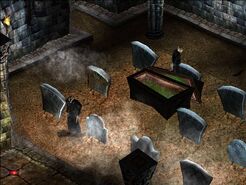
DK2: Graveyard
The Graveyard appears in both Dungeon Keeper 1 and 2 and serves the sole purpose of adding vampires to the Keeper's menagerie. When enemies are killed in battle, their corpses will dragged to the Graveyard for burial. When ten enemies have decomposed in the Graveyard, a vampire will be spawned and will join the Keeper's army.
Graveyards can be quite expensive to build and the vampires spawned from it are also the most costly of creatures, but may well be worth the investment as they possess a wide variety of abilities. Great care must be taken with housing them as they do not get along with Warlocks and so will likely require their own Lair and Library separate from the rest of the horde.
Temple[]
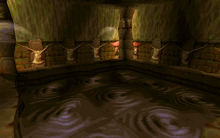
DK1: Temple
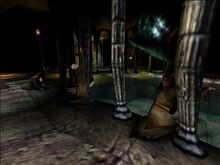
DK2: Unholy Temple
The Temple (or Unholy Temple as it is known in Dungeon Keeper 2) is a place where creatures may go to worship the Dark Gods. Just because the creatures of the Underworld are bloodthirsty and evil doesn't mean they have no faith. The Temple serves to help lighten the mood of creatures who pray there, making them less prone to anger and fighting amongst themselves or leaving the dungeon. In DK1, this room is especially useful in keeping Horned Reapers from going crazy out of boredom, provided they have a Temple of their own that they don't have to share with anyone else. Also, any creatures within the Temple cannot be scavenged by rival Keepers.
As well as being a place of stress relief for creatures, the Keeper may also make sacrifices to the Dark Gods. By sacrificing specific groups of creatures, the Keeper may be rewarded by the gods, whether it be with a stronger creature, a bewitched hero, more gold or accelerated research. In DK1, certain sacrifices may also anger the gods and they will punish unworthy offerings by afflicting all of your creatures with disease, making them angry or destroying the dungeon's food supply.
In DK1, the Temple appears to be crafted from pale-yellow stone with golden Horned Reaper heads adorning the walls. A well filled with a murky, misting liquid sits in the centre which the Keeper may drop creatures into as sacrifices to the gods. The Unholy Temple in DK2 looks darker and more foreboding, and will contain two large stone hands within the sacrificial pool. This room can also attract Dark Angels to the dungeon.
Scavenger Room[]
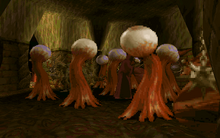
The Scavenger Room is a room that only appears in Dungeon Keeper 1. It will be the last room to become available and is also the most expensive. At its minimum effective size of 3x3 tiles, it appears as a dank cavern with a large eyeball on a fleshy red stalk standing in the centre, with more of these eyeballs appearing as the room is expanded. Within the Scavenger Room, sinister, tempting whispers can always be heard.
The purpose of the Scavenger Room is to make contact with creatures from rival dungeons. From here, your creatures can communicate with others belonging to another Keeper, tempting them to defect from their Keeper and join your ranks. Likewise, other Keepers can do the same to you if they have a Scavenger Room, but an enemy Keeper's scavenging attempts can be blocked by placing a scavenged creature in the Temple.
Casino[]
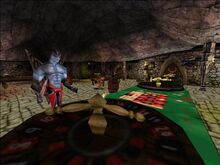
The Casino appears exclusively in Dungeon Keeper 2. After a hard day’s work slaughtering and carrying out your nefarious bidding, there’s nothing your creatures enjoy more than a flutter and a mug of ale at the Casino. As Keeper, you decide the level of payouts at the Casino. If you set the payout levels high (Smiley) then your creatures’ happiness ratings rise. If you set them low ($), you stand to make more money, but at a cost to your creatures’ happiness ratings. It can be difficult to find the right balance between making money and keeping your creatures entertained and complacent, but potentially worth the investment.
Combat Pit[]
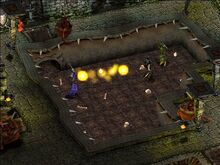
In Dungeon Keeper 2, the Training Room can only elevate creatures up to Level 4. However, the Combat Pit can take creatures up to the full Level 8. The Keeper may place any creatures they want into the Combat Pit where they will fight each other until reaching Level 8, or until they are knocked out, or all other creatures are knocked out. If imps are not nearby to pick up the fallen and take them to their lairs, they will die. Creatures within the pit have to be fighting to gain experience. Any mixture of creatures can be placed in the pit. It is also possible to drop enemy creatures from the Prison and will function the same.
When fighting in the pit, creatures only take 20% of normal damage and do double melee damage.
List of Creatures[]
Below is the complete list of creatures that appear in the Dungeon Keeper games.
- Imps - The basic labourers of the dungeon, imps are essential to maintaining and expanding your domain. They will dig tunnels, claim land, fortify walls, mine gold and collect bodies if need be. They do not eat, sleep or demand payment for their service. However, the Create Imp spell is the only way to acquire imps and becomes more expensive depending on how many imps already occupy the dungeon.
- Flies - One of the first creatures to appear in Dungeon Keeper, these bugs are feeble but fast, making excellent scouts. They require only the bare necessities of a Treasury, Lair and Hatchery to be attracted to the dungeon.
- Beetles - One of the first creatures you will acquire in DK1, Beetles are basic at everything and have no specialities. In later stages, these insects will be rendered obsolete by more capable creatures and stop coming to your domain altogether.
- Fireflies - Appearing in Dungeon Keeper 2, Fireflies serve the same purpose as their predecessors from the first game. What sets them apart is that they have their own light source.
- Spiders - These vile arachnids appear in DK1 and make good defenders during early stages of the game. However, they will attack any Flies that share their lair-space.
- Goblins - Appearing in DK2, goblins are basic units that do not excel at any particular task. They will eventually be rendered obsolete in later stages.
- Demon Spawn - Reptilian beasts that appear solely in DK1. These creatures live to fight and will spend all their time bulking up in the Training Room if left to their own devices. When they reach Level 10, they evolve into Level 4 Dragons.
- Dragons - Wicked, powerful and notoriously greedy, Dragons will make excellent additions to any dungeon, provided one has enough gold to afford their services.
- Warlocks - Sorcerers cast out from the Overworld for delving into the forbidden Black Arts. Always seeking to expand their arcane knowledge, a sizeable Library is sure to attract several of these lethal spell-slingers.
- Bile Demons - Fat, repulsive creatures known for their gluttony and their flatulence, but they also make fine warriors and builders.
- Trolls - Industrious creatures who will be right at home in the Workshop, pumping out doors and traps to fortify your dungeon.
- Orcs - Similar to Trolls, but more inclined to help defend the dungeon by throwing their hammers down on the skulls of their enemies then on the scraps on a workshop bench.
- Dark Elves - Exclusive to DK2, these sinister elves make superb long-range combatants.
- Rogues - Human crooks and cutthroats that have fled the Overworld to seek their fortune as hired mercenaries.
- Tentacles - Exclusive to DK1, Tentacles are the rarest creatures in the game, though they have no particular specialities and are only drawn to dungeons with large Lairs built next to bodies of water.
- Dark Mistresses - Sultry, seductive and sado-masochistic, Mistresses enjoy both inflicting and receiving pain and can be attracted to dungeons with Torture Chambers.
- Skeletons - When heroes starve to death in the Prison, their skeletons will reanimate as easily-managed foot soldiers that do not need to eat or sleep. They exist only to fight and can be easily replenished as long as there are more enemies to lock up and withhold food from.
- Ghosts - The tormented souls of those who died in your Torture Chamber become anchored to the dungeon, forced to serve your wicked cause.
- Vampires - The most powerful of all the undead creatures, and also the most expensive overall. But the wide variety of spells they wield is worth the investment provided you can keep them and the Warlocks from killing each other.
- Hellhounds - Two-headed canines emerging from the fiery bowels of the Pit, their speed and ability to traverse lava make them excellent scouts.
- Salamanders - Reptilian creatures that thrive in lava and the blood of their enemies.
- Maidens - Half elf, half spider, all evil. These creatures only appeared in Dungeon Keeper 2 after the release of the 1.7 patch.
- Black Knights - Overworld knights that have gone against their code of honour and chivalry, dedicating their swords to whichever master will satisfy their thirst for battle.
- Dark Angels - Former servants of the Divine cast down into the Underworld for turning against the Gods. While willing to offer their strength to the cause of a Keeper, they are ultimately self-serving and wish to destroy all that is good.
- Horned Reapers - The most deadly and savage of demons, Horned Reapers are near-unstoppable engines of destruction. So violent are they that few Keepers can keep them under control, but those that do possess invaluable assets that will all but guarantee victory against the forces of good.
